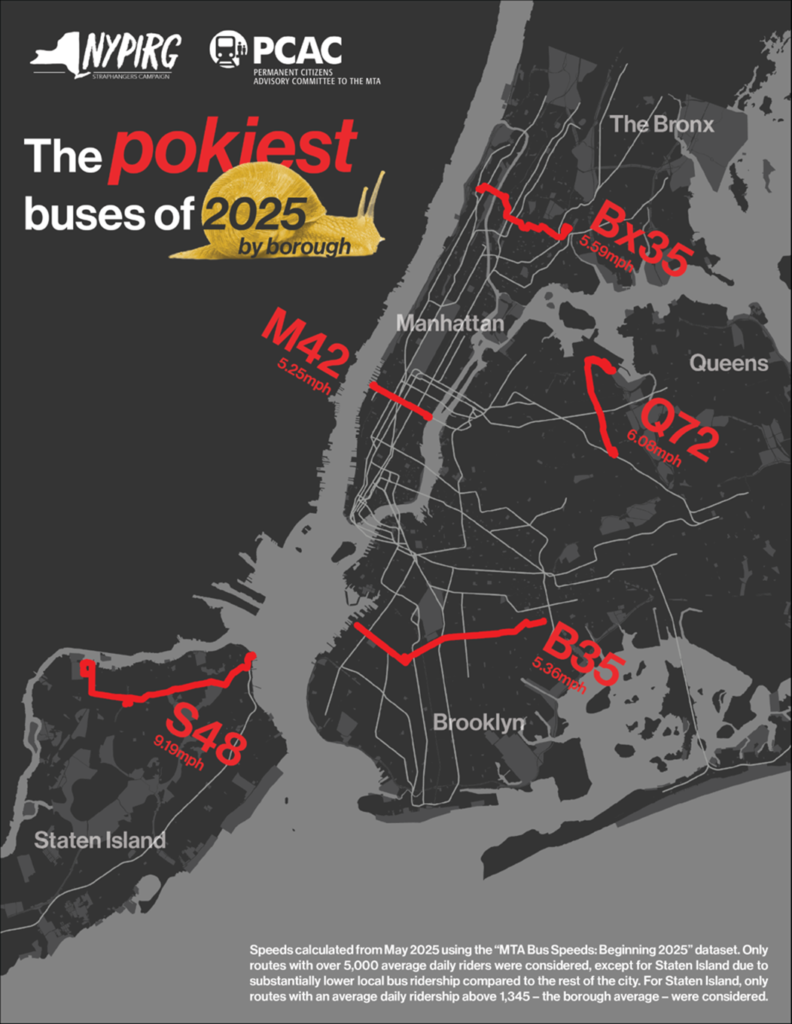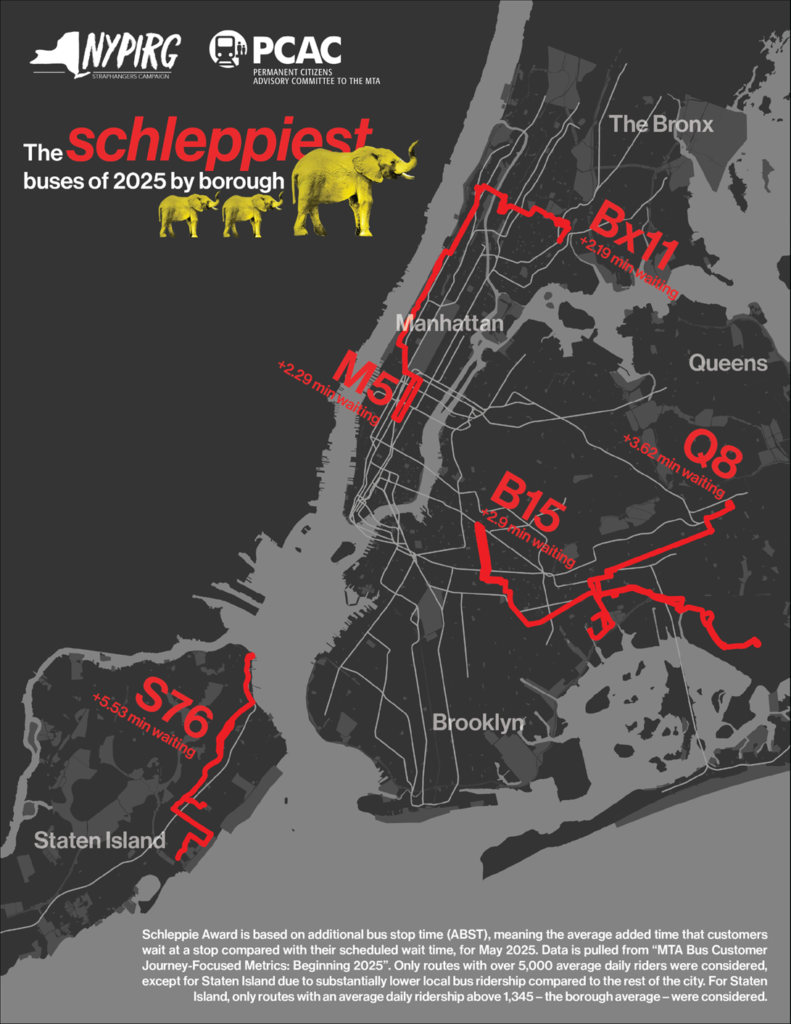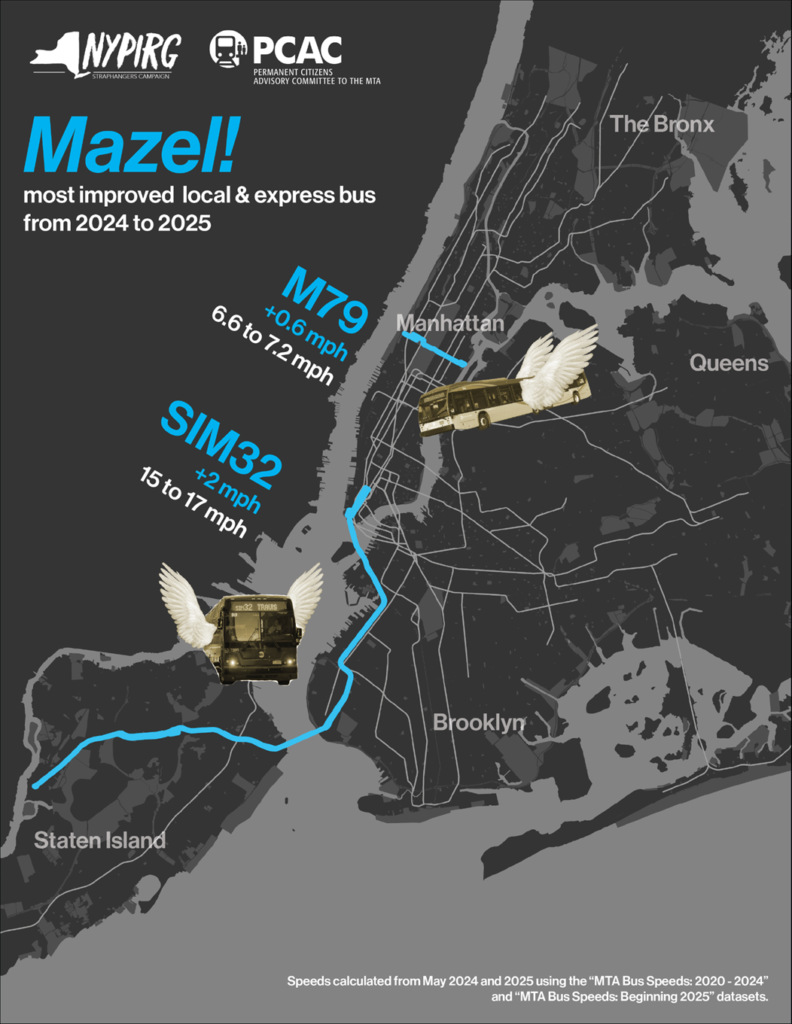Acknowledgements
This report was written by Megan Ahearn and Natasha Elder with the New York Public Interest Research Group (NYPIRG) Straphangers Campaign, and Brian Fritsch, Kara Gurl, and Henry Mei of the Permanent Citizens Advisory Committee to the MTA (PCAC). Data analysis was conducted by PCAC. Images were created by Megan Ahearn. Maps were created by Henry Mei with NYC Open Data and mass transit data layers compiled by Anastasia Clark, Frank Donnelly & Zhi Keng He using GTFS data from the Metropolitan Transportation Authority.
Since 1979, the NYPIRG Straphangers Campaign has organized the riding public – college students, in particular – to speak up for affordable fares, more attractive service, and the continued rebuilding and expansion of public transit.
Created by the New York State Legislature in 1981, the Permanent Citizens Advisory Committee to the MTA (PCAC) serves as the official voice of riders of the subway, bus, Staten Island Railway, Long Island Rail Road, and Metro-North Railroad, advocating for affordability, transparency, accessibility, and equity across the MTA system.
Executive Summary
With renewed focus on buses and speeding the trips for the millions of riders who rely on them, the New York Public Interest Research Group (NYPIRG) Straphangers Campaign and Permanent Citizens Advisory Committee to the MTA (PCAC) announced reinvigorated Pokey and Schleppie Awards for poor bus service, and creation of a new category – the Mazel – for most improved.
This year marks the 18th in the series of the dubious recognition awards, which were last issued in 2022. The latest awards measured bus speeds and reliability as of May 2025 (prior to implementation of the Queens Bus Network Redesign.) The advent of congestion relief has helped improve even the worst line, and even more progress will be possible following implementation of the Bus Network Redesign projects. A clear take-away is the need for complementary efforts such as bus lanes, enforcement, and bus priority projects.
The 2025 Pokey and Schleppie Award “Winners”
Metropolitan Transportation Authority (MTA) and New York City Transit (NYCT) local bus routes which have 5,000 daily riders or more were eligible for the Pokey and Schleppie Awards (see Methodology, Appendix D).
- The “winner” of the 2025 Pokey Award is the M42, clocking in at 5.25 Miles Per Hour (MPH). It had the slowest speed out of the high-ridership bus routes reviewed by PCAC and the Straphangers Campaign. Positively, the M42 runs faster than the most recent Pokey winner in 2022, we believe that’s in large part because of the launch of congestion relief.
- The “winner” of the 2025 Schleppie Award is the Q8, with riders waiting on average 3.62 minutes longer than the scheduled wait time between buses. It had the least reliability out of the high-ridership bus routes reviewed by PCAC and the Straphangers Campaign. With the Queens Bus Network Redesign now fully implemented, here’s hoping the schleppie Q8 sees some pep in its step next year.
Announcing: The 2025 Mazel Award!
While some routes continue to crawl, others have shown meaningful improvements over the past year. The inaugural “Mazel Award” is awarded to both the standard and express bus routes that have improved their average speeds the most between May 2024 and May 2025 (see Methodology, Appendix D).
- The winner of the inaugural Mazel Award for standard buses is the M79+, which improved from 6.63 to 7.25 Miles Per Hour (MPH).
- The winner of the inaugural Mazel Award for express buses is the SIM32 (Travis Staten Island – Lower Manhattan), which jumped by more than 2 MPH to reach an average of 17.14 MPH.
Recommendations
Well-targeted reforms with consistent on-the-ground enforcement can realize riders’ dreams: Fast, reliable bus service.
- New York City must implement the mandated Streets Plan and install more busways and priority bus lanes, such as those implemented on 14th Street in Manhattan, to cut delays and boost reliability.
- Properly enforce busways and priority bus lanes.
- Build on improvements in traffic congestion by investing in signal priority technology and active headway management.



FINDINGS & RECOMMENDATIONS
In New York City, mass transit defines where you live, where you play, and where you go to school. It is the “great equalizer” of opportunity and why accessible, affordable, and safe transportation is so important.
Many New Yorkers depend heavily on bus service for daily travel and can attest to the fact that the city’s buses are notoriously slow. Yet, as this report finds, overall, bus speeds showed meaningful improvement compared to the last report in 2022.
Well-targeted reforms with consistent on-the-ground enforcement can realize riders’ dreams: Faster, more reliable bus service. Busways and priority lanes, such as those implemented on 14th Street in Manhattan, have proven effective in cutting delays and boosting reliability when properly enforced. Where traffic has been eased through congestion relief in Manhattan, riders are beginning to experience quicker, more consistent bus trips. The challenge ahead is ensuring that these benefits extend citywide, particularly to routes outside Manhattan.
The MTA is currently undergoing a series of borough Bus Network Redesigns that are making stop-level and route-based upgrades to each borough’s bus network. Up to this point, the Bronx Bus Network Redesign has been in effect since 2022, and the Queens Bus Network Redesign finished implementation in August of 2025.
The lesson is clear: pairing congestion pricing with robust bus priority measures can transform the rider experience, while relying on either one in isolation leaves riders only marginally better off. Expanding proven strategies — such as dedicated busways, signal priority, and active headway management — can turn today’s incremental improvements into a system-wide shift toward fast, dependable bus service. The mandated Streets Plan can support these efforts, and New York’s next Mayor should make its implementation a priority to improve service for bus riders across the five boroughs.
